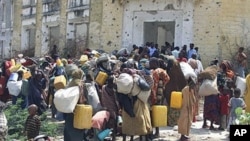Analysts and aid workers say a lack of proper forecasting, skyrocketing food prices, marginalized populations, extreme poverty and insecurity have turned the severe drought in East Africa into a humanitarian disaster.
The disaster response coordinator for British-based Plan International, Unni Krishnan, is one of many among aid agency workers raising the alarm on the severity of the current situation. "As we speak today, more than 10 million people in East Africa are going through one of the worst crises in living memory and this is one of the worst droughts in the last, more than 50 years. And children are in desperate need of food, nutrition, water and other life-supporting mechanisms. We need to act now. The situation is very, very bad," said Krishnan.
Aid workers say this year’s failed wet season has created a triangle of hunger where the borders of Ethiopia, Kenya and Somalia meet. Parts of Djibouti and Uganda have also been affected.
In Somalia, aid workers say the effects of the drought have been compounded by rising food prices, estimated at more than 200 percent in the last year, ongoing conflict, and nearly inexistent health systems.
It is estimated that one in three children in southern Somalia is severely malnourished. Thousands of Somalis are reported to be fleeing into Kenya and Ethiopia on a daily basis. Many of the drought victims were previously displaced.
More than two million young children in East Africa are reported to be malnourished, and a half million are estimated to be in need of urgent life -saving actions.
For Krishnan from Plan International, it is a sad reminder that much more needs to be done to prevent droughts from turning into disasters. “Droughts, they are a recurring phenomenon in the region, so this needs long term vision and long term responses. We are afraid that this response is not going to be a 100-meter sprint, this is going to be a marathon race. It is important to look at long-term disaster risk reduction measures, dealing with issues of agriculture. There are new technologies that are in place where agriculture is possible with limited water but unfortunately that is not available for that part of Africa," said Krishnan.
Krishnan says dealing with conflict, poverty, the lack of infrastructure and education are part of the solution.
Other aid workers stress more farmers should turn to resilient crops such as millet and sorghum, and also install rain harvesting tanks and drip irrigation schemes.
The co-author of a recent book about droughts, Eric Wood, from Princeton University, has also been working with UNESCO, the UN educational, scientific and cultural agency, on an experimental African drought monitoring system.
He says once it is up and running, hopefully starting in December with a base in Niger, the system could also be very important. “For central governments, for regional institutions, for external agencies like USAID, I think that they need to see large-scale patterns. What you may see at a very local scale just may not be representative and so I think that is important to offer a regional to continental scale. Our hope down the road is in fact to combine the monitoring part with in fact a seasonal forecasting part.”
Wood says the system could forecast severe droughts up to three months in advance, allowing for more effective disaster planning.
The forecasting could also help African farmers deal with increasingly erratic rain patterns.
Currently, though, many aid workers, like Nicholas Wasunna, with the aid group World Vision Kenya, are expressing enormous frustration. “We need to do much more, especially in disaster risk reduction. We need to make disaster risk reduction a political priority and invest accordingly because these scenes we should never see again. The reality is drought will continue to be with us, but we need to do much more, much sooner," he said.
Wasunna spoke from the home of an increasingly malnourished elderly man who has been staying in bed all day inside his makeshift tent in northeast Kenya, after the drought killed all his cattle.
East Africa’s Drought Brings Triangle of Hunger And Questions










